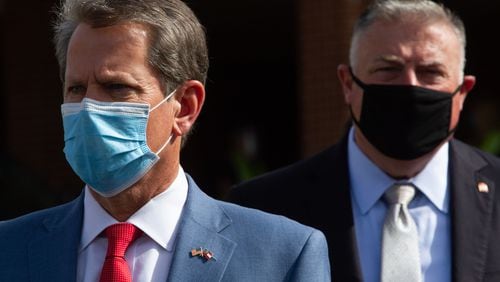As Congress struggled last week to reach a deal on the latest coronavirus relief package, alarms were again being raised that the lack of federal aid could mean years of service cutbacks, layoffs and employee furloughs for state and local governments across the country.
Georgia, which has avoided mass furloughs, has fared better than many other states. Nationally, about 1.5 million college, school and other government workers were laid off or furloughed during the early months of the COVID-19 recession, eclipsing the declines during the Great Recession, according to U.S. Department of Labor figures.
Without federal assistance to fill holes in state and local budgets, some analysts have said spending cuts and tax increases that communities may need to continue providing services could delay the country’s recovery.
“The federal government is the only institution in the position to dig us out of this hole,” said Steven Kreisberg, special assistant to the president of the American Federation of State, County and Municipal Employees, the largest trade union of public employees in the country. “If Congress doesn’t act, the outlook is exceedingly grim.”
Former Philadelphia Mayor Michael Nutter, who led the city during the Great Recession, said local governments won’t be able to cut their way out of multiyear deficits.
During a webinar put on by two policy and research groups, the Volcker Alliance and the Penn Institute for Urban Research, Nutter said the fact that Congress is still debating state and local aid “is an absurd discussion and a dereliction of duty by the federal government.”
The National Governors Association requested a $500 billion aid package for states in April, and many legislative leaders from both parties in Georgia and nationally backed the idea.
But some congressional opponents, such as U.S. Senate Majority Leader Mitch McConnell, R-Ky., say the federal government should slow spending, and they don’t want to “bail out” states that they say have been irresponsible in the past.
The American Legislative Exchange Council, which writes conservative model legislation for lawmakers, said last week that more than 200 legislators from across the country have signed a letter opposing federal aid to states. ALEC said such a package would raise the already ballooning national debt and lead to higher state taxes and spending.
There are nearly 7,400 state lawmakers across the country.
Ben Scafidi, a Kennesaw State University economist and director of the Education Economics Center, said Congress should hold off for a year. Most states — like Georgia — have reserves, as do local governments and school districts, that they can use to fill budget gaps.
“I think we should use those first,” Scafidi said last week during a web forum put on by the Georgia Public Policy Foundation.
But he also quickly predicted, “There is going to be (federal) funding for state and local governments, including school districts.”
Most of the headlines from the latest COVID-19 package debate have centered on extending enhanced unemployment benefits for millions of unemployed Americans or whether to include another round of $1,200 stimulus checks.
But many of the more than 20 million people who work in state and local governments are also keeping an eye on what any plan would offer to help relieve budget pressures that could last for years.
The Democratic-led U.S. House backed a $3.5 trillion spending proposal that includes about $1 trillion in relief for states and local governments. The Republican-led Senate’s spending plan, totaling $1 trillion, offers no new money to governments but gives them more flexibility in how to use some of the aid Congress previously approved, something Georgia officials have supported.
It’s more than an academic debate for the people running cities, counties, school districts, colleges and the state. Georgia state agencies will soon be given instructions from the governor’s office on what they can expect in fiscal 2022, the budget year that starts next July 1. While they may not be requested to suggest new spending cuts now, the long-term outlook is unclear.
The COVID-19 recession threw millions of Americans out of work and closed businesses, suppressing spending and use of services that helps pump tax revenue into state and local government coffers.
That, in turn, has left yawning holes in budgets spent educating students, policing communities, providing health care, building and maintaining roads and parks, and serving a host of other functions.
Unlike the federal government, states can’t spend more than they take in. So if Gov. Brian Kemp says the state will have $26 billion in revenue this year — as he did in June — that’s the most it can spend.
The federal government allocated huge pots of money for states, school districts and local governments in March to deal with the pandemic, and that has helped them weather the public health crisis. The Atlanta Journal-Constitution reported last month that the state incurred about $880 million in pandemic expenses during the first few months of the health emergency.
However, the federal funding had a catch: It couldn’t be used to fill holes in state budgets for nonpandemic-related expenses.
Schools and universities also received money, but it didn’t make up for the loss of revenue colleges saw during the spring and summer semesters due to the pandemic.
The reserves the state and school districts in Georgia have built since the Great Recession played a huge role in softening the budgetary blow — at least for the current fiscal year. Lawmakers in June passed a state budget that cut $2.2 billion in spending — including $950 million in basic aid to school districts.
But only weeks earlier state agencies considered more drastic measures, proposing large-scale layoffs and furloughs of thousands of state workers.
Budget writers said that school districts in Georgia had amassed more than $3 billion in reserves — more than the state had in the bank. So many districts could handle the state spending cuts this year without having to cut programs or furlough teachers.
The state also benefited from a temporary federal increase in payments for Medicaid — the public health care program for the poor, disabled and nursing home patients. While more Georgians are signing up for the program, the federal government is providing increased aid.
After an initial, huge drop-off, tax collections also haven’t been as bad as some officials feared.
With so many Georgians receiving unemployment benefits and — up to now — getting an enhanced $600 weekly federal payment, state Senate Appropriations Chairman Blake Tillery, R-Vidalia, said the state has gotten a temporary boost in tax withholdings.
Instead of getting a few million dollars a month from unemployment income taxes, he said the state has been collecting more like $120 million to $135 million a month.
“We’re going to see what that’s going to do for the future,” he said. “I’m concerned that that may have artificially held up our revenues a little bit where things may not look quite as bad as they really were.”
Tillery said even with the temporary boost, “next year’s revenues at best are flat and will be likely lower than what we have in our 2021 budget.”
Marcia Van Wagner, vice president-senior credit officer for Moody Investors Service, which provides credit ratings, risk analysis and research, said it’s likely that state and local governments will be passing austerity budgets for several years, as they did during the Great Recession.
“The public sector has taken an enormous revenue hit,” she said. “It will take years to recover from it.”
During a webinar on state and local finances last week, New York Comptroller Thomas DiNapoli said there are projections his state will lose $55 billion in revenue over the next few years.
“It is certainly expected that it’s going to be at least two to three years before we return to pre-COVID levels of tax revenue,” he said. “It’s very, very clear this is not a one-year budget or revenue problem.”
“
About the Author








